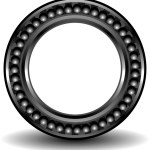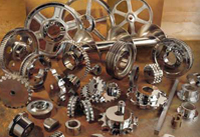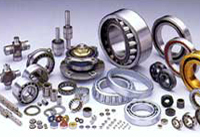 When it comes to bearings, there are many types specifically designed to be used in a multitude of unique applications. Bearings can be found everywhere – in cars, appliances, furniture, tools, clocks, toys, and more. If you stand in just about any room in any house, business office, or storefront, there will likely be a myriad of bearings in use in just that one room. The American Bearing Manufacturer Association provides a helpful description of what a bearing is and how, generally speaking, it works, “Bearings are highly engineered, precision-made components that enable machinery to move at extremely high speeds and carry remarkable loads with ease and efficiency. Bearings must be able to offer high precision, reliability and durability, as well as the ability to rotate at high speeds with minimal noise and vibration…If something twists, turns or moves, it probably has a bearing in it.” There are many different types of industrial bearings and below we explore three different types including what type of applications in which they are most commonly used.
When it comes to bearings, there are many types specifically designed to be used in a multitude of unique applications. Bearings can be found everywhere – in cars, appliances, furniture, tools, clocks, toys, and more. If you stand in just about any room in any house, business office, or storefront, there will likely be a myriad of bearings in use in just that one room. The American Bearing Manufacturer Association provides a helpful description of what a bearing is and how, generally speaking, it works, “Bearings are highly engineered, precision-made components that enable machinery to move at extremely high speeds and carry remarkable loads with ease and efficiency. Bearings must be able to offer high precision, reliability and durability, as well as the ability to rotate at high speeds with minimal noise and vibration…If something twists, turns or moves, it probably has a bearing in it.” There are many different types of industrial bearings and below we explore three different types including what type of applications in which they are most commonly used.
3 Types of Industrial Bearings and How They Are Used
- Ball Bearings
- Balls bearings are some of the most commonly used be bearings in general manufacturing. Ball bearings contain balls that reduce friction and facilitate movement. Ball bearings can be tiny enough to fit inside small mechanisms or large enough to fit inside large industrial machines. Ball bearings have been in use for hundreds of years and because the balls roll along with the mechanism, they provide a significantly reduced amount of friction. Though they are incredibly useful for certain applications (light and general use), they have a smaller load capacity than other types of bearings that can accommodate a larger load capacity. Ball bearings are used in fans, skateboards, washing machines, DVD players, satellites, telescopes, automotive parts, medical and dental equipment, and so much more.
- Linear Bearings
- There are many different types of linear bearings. These bearings are also known as linear-motion bearings and are frequently used to provide smooth linear motion and help carry a load along a rail. These types of bearings can be used for things like pull out drawers, storable work surfaces, medical and dental devices, aerospace applications, railway applications, special vehicles, packaging and logistics, industrial machines, furniture, and more.
- Sleeve Bearings
- Sleeve bearings are very commonly used in a vast range of applications. Sleeve bearings are typically constructed of hard metals. Sleeve bearings are low friction bearings and dramatically reduce mechanical noise. A rod is inserted into the sleeve which has been oiled and provides smooth, virtually friction free movement. To work properly and not wear out a sleeve bearing prematurely, it must be continuously supplied with adequate lubrication. Sleeve bearings are self-lubricating but they should be routinely checked to ensure they have adequate lubrication. Sleeve bearings are commonly used for things like drive shafts, packaging applications for the food industry, transmission shafts, turbines, propeller shafts, and more.


















